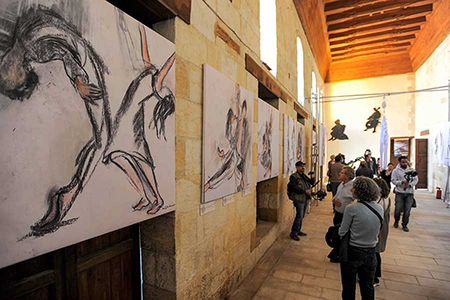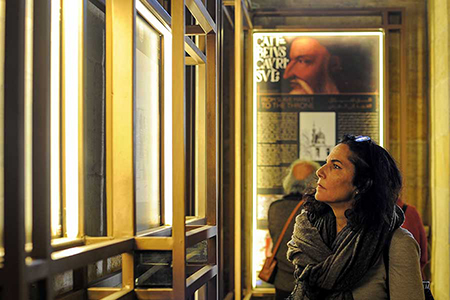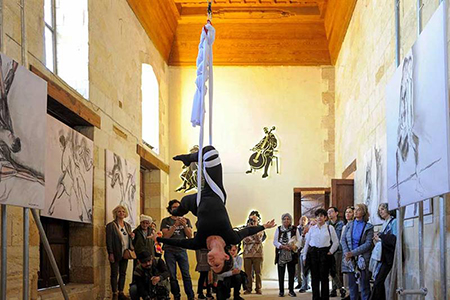Titled Celestial Pas de Deux, the multimedia exhibition features sculpture, installations, dancing performances, video projections, and music, all set within one of the most perfect examples of 15th century Mamluk architecture.
The title of the exhibition references the ballet term ‘pas de deux’ which refers to a dance performed by a pair.
The historical location is a marvellous setting for some twenty drawings on canvas, in pencil and in charcoal.
Furthermore, the drawings are complemented by 24 modern sculptural installations representing human bodies, men and women, flying over the two spacious rooms of the old building.
The bodies are often presented in pairs and are in constant motion. Hanging from the ceiling, they look like celestial bodies, especially under the influence of the music that while looping fills the location.
A multimedia system makes it possible to project a video of the French pianist Yann Tiersen playing a composition by Porz Goret. Only the sound of the wind accompanies the piano, creating a unique mood with a melancholic melody that puts visitors in a state of ecstasy.
Rana Chalabi's characters move delicately in pairs, performing a kind of aerial dance, where everything is in harmony. All the dualities are thus combined: the irrational, the imaginary, the carnal, the spiritual, the mystical, the sentimental...

The visual artist herself has always followed esoteric paths such as those practiced by Sufis in ecstasy and by whirling dervishes in full meditation.
“Movement fascinates me, it is an act of power. It constitutes for man the most fundamental experience, and creates a link between humans and the world. Heavy bodies (natural beings) fall like a stone, while light bodies (divine beings) rise like fire. Movement is life, and I want people to feel that movement,” she says.
Attached to the ceiling by wires, the figures of Rana Chalabi, in galvanized steel, wear tutus or pants, as the case may be. Women and men are free, suspended in the air. They pivot in pairs, move from left to right, following a changing rhythm, sometimes slow, sometimes fast.
Chalabi attempts to create action because action creates movement and movement draws individuals into continuous circles. The 24 twirling sculptural installations are finely spangled in multiple colors. These sequins represent the joy of the heart, which emanates from the divine, from spiritual love.

The artist explains: “The dancers in the exhibition Celestial Pas de Deux embody the feminine and masculine principles of the universe. Installed in a dark room, the sequins that adorn their bodies sparkle thanks to the effect of three projectors. The characters are like stars or angels… They radiate beauty and holiness. God is beautiful; he loves beauty. Sequins reflect everyone's inner light. Each of us must find our inner light, we must know how to sparkle our life. Let's all dance, shine and twirl.”
The second room of the historical Madrasa hosts three thin metal plates of black color, in the form of human silhouettes, man-woman, musicians and dancers, as well as several drawings, in pencil and charcoal, showing couples.
Chalabi, who is a disciple of the great Egyptian architect Hassan Fathi, uses his experience and skills in architecture as she searches for purity and simplification through using geometric shapes.
A holder of a degree in architecture and art from the American University of Beirut in 1981, Chalabi has always nurtured a very special relationship with abstraction. Squares, rectangles, triangles and circles interact with the artist's characters, often in pairs.
The circles are among the recurrent forms presented by Chalabi. This is due to its perfect symmetry. As the artist clarifies, it is one of the first forms drawn by human beings; it has no beginning or end, making it a universal symbol of eternity, perfection, divinity, infinity and beauty.

Rana Chalabi, a Syrian/Lebanese artist, has made Cairo one of her homes for over 35 years alongside Beirut and Amsterdam.
"Chalabi's work reflects her varied interests and is dominated by the preoccupation with movement, both physical and spiritual," reads the artist's biography, which also tells us that she is “fascinated with Sufism, and related subjects often appear in her work. The visionary artist works in various media and techniques."
Chalabi has had numerous exhibits in Cairo as well as in Paris, London, Vienna, Beirut, Tokyo, and in the Arab-American Museum in the US.
MASQ stands for Maq‘ad of Sultan Qaitbey. The arts and culture centre operates in the grand reception hall in the Sultan’s magnificent funerary complex in the “Desert of the Mamluks” and the adjacent oratory. The 15th-century buildings were expertly restored by ARCHiNOS Architecture with funding primarily from the EU and opened to the public in 2016 and 2018 respectively. MASQ is now used as a multi-purpose space that houses Egyptian and international visual and performing arts events, as well as an extensive community outreach programme.
The exhibition opened on 18 March and continues until 20 April 2023
Short link: